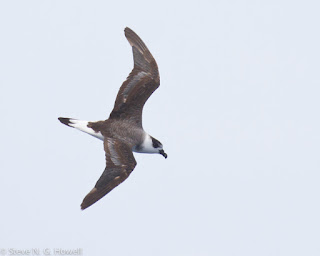In between this bird cruised over how many miles of ocean? It also makes one ponder the efficacy and accuracy of counting birds at sea, and it will be interesting to see if it shows up on another day…
As with yesterday, large shearwaters were scarce, although Cory’s and Great were both seen. Audubon’s Shearwaters were again numerous and showed well, often wheeling fairly high to suggest small gadfly petrels and keep us alert. Wilson’s Storm-Petrels stayed with us throughout the day on the chum slick, as usual offering photo challenges (“they’re too close” was the main “problem”), plus the background noise from which to pick out Band-rumped Storm-Petrels. All of several Band-rumps seen well were of the winter-breeding Grant’s type, with obvious wing molt (see yesterday’s blog post for comments on taxonomy).
Flyingfish put on some good shows, with large numbers of Sargassum Midgets (juveniles)
transitioning into Purple Bandwings (immatures),
plus numerous adult Atlantic Patchwings,
although capturing images was a challenge in the choppy seas. Shortly before heading back for shore a Common Tern made a fly-by to close out another day at sea in the deep blue desert of the Tropical Atlantic, the second biggest desert on Earth after the tropical Pacific (it has been said that while the Pacific is vast, the Atlantic is only half vast...). Any day you see so many Black-capped Petrels so close is a special day, and we even made it back to shore before some torrential rain storms passed through. Now time for a good sleep before another day.
(Thank you to everyone who came offshore with us today! Thank you to Steve & Ed for helping us out and a big thank you to Steve for providing the blog and photos!)
Species List for June 3, 2018
Black-capped Petrel 43-45
Cory's Shearwater 14-15
Great Shearwater 2
Audubon's Shearwater 45
Wilson's Storm-Petrel 80-90
Band-rumped Storm-Petrel 6-8
Common Tern 1









No comments:
Post a Comment